| Back to Back Issues Page |
 |
|
Bangkok Travelbug January 11 Paknam the forts of crouching tigers December 30, 2010 |
| Hello
Paknam – the Chao Phraya estuary Paknam, the area around the mouth of the Chao Phraya River, has traditionally been the entrance to old Siam when the main mode of transport was by sea. Since the Ayutthaya days, trading ships of many nations have sailed through this estuary. When the centre of power was in Ayutthaya, 100 km from the river mouth, forts were constructed in present day Bangkok to protect the approaches to Ayutthaya. When Bangkok was established as the capital, it became more vulnerable as the distance to the river mouth was just 30 km. It became imperative to have defences right at the estuary. The customs house was moved to where the provincial capital Samut Prakarn is currently located. Ships on arrival were required to remove their cannon before proceeding further upriver. A defence of the estuary was thus required. Paknam is in Samut Prakarn, a province just south of Bangkok and like Bangkok, straddles both banks of the Chao Phraya. Samut Prakarn city, the provincial capital, is still called Paknam by the locals and the market there, Paknam Market. 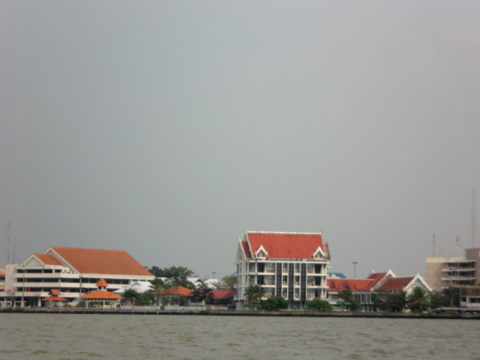
Paknam – Samut Prakarn city, the provincial capital The province has a long association with the navy. The Naval Academy is located here. So were the river forts. The name Samut Prakarn reflects this heritage, samut – sea, prakarn – fortifications. Please see map of Samut Prakarn. View Samut Prakarn Province in a larger map Table of contents Indo-China 18th – 19th C The Lao and Cambodian kingdoms have long been an area of conflict and instability since the Ayutthaya days. In the reign of King Taksin (1767 – 1782), Battambang and Siem Reap in Cambodia were invaded and annexed in 1769. In 1778, the Lao kingdoms of Champassak, Luang Prabang and Vientiane were similarly subdued. In the reign of King Rama I (1782 – 1809), the Cambodian territories of Battambang, Siem Reap and the Cambodian court at Udong were brought under Siamese influence by supporting rulers who were pro-Siam. Between the 18th and 19th centuries these kingdoms continued to be plagued by internal power struggles and rebellions. Both Siam and Vietnam competed for control over these kingdoms by installing their protégées as rulers. The see-saw struggle between Siam and Vietnam continued into the reign of King Rama III (1824 – 1851). By 1846, after a costly three year war, the Cambodian court, now in Phnom Penh and the western territories of Battamabang and Siem Reap were firmly under Siamese influence. Siamese influence now extended to present day Laos and Cambodia. However, events in the second half of the 19th century would bring an abrupt end to this. The entry of France to Indochina caused a major shift in the regional balance of power and had serious consequences for Siam. France saw the Mekong River as a conduit to the wealth of the region and China and proceeded to secure territories along the Mekong. In 1863, France colonised Vietnam and made Cambodia a protectorate. This was a harbinger of worse to come three decades later. Table of contents The defence of Paknam By the middle of the 19th century, the presence of two colonial powers in SE Asia, Britain and France, made it necessary to strengthen the defences of Paknam, a major point of entry to the kingdom. The defence of Paknam was based on more than 20 river forts all the way from Phra Pradaeng to the estuary. These forts were grouped around three main defensive clusters. Phra Pradaeng Starting from upriver, ten forts were built in this area where the Chao Phraya makes a sharp bend around the Phra Pradaeng neck of land. 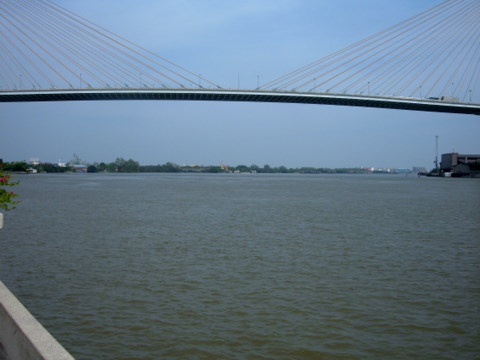
The Chao Phraya makes a sharp bend to the right, around Phra Pradaeng, then curves back to the left. The Phra Pradaeng forts dominate this stretch of the river Samut Prakarn city The second cluster of 6 - 7 forts were strung out from the north of Samut Prakarn city, within the city and south of it. Phra Samut Chedi Across the river from Samut Prakarn were two forts in the Phra Samut Chedi area, one fort is on the mainland and another Fort Phi Suea Samut is on an island in the Chao Phraya. 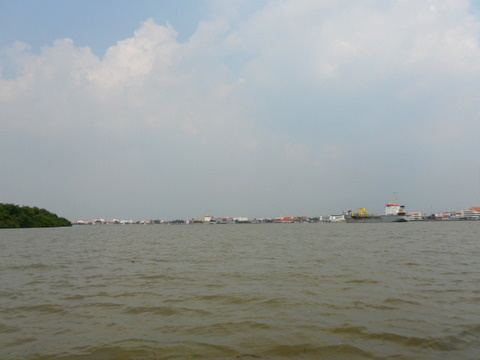
The stretch of the Chao Phraya between the Samut Prakarn city forts (buildings in the distance) and Fort Phi Suea Samut (the tip of the island on the left) Fort Phra Chulachomklao At the river mouth, stood the newest fort, Fort Phra Chulachomklao, which took 9 years to build and was completed on 10 April 1893. 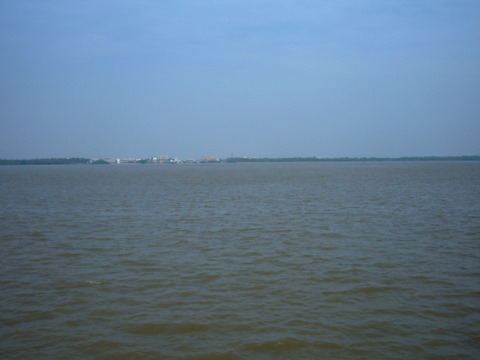
The Chao Phraya estuary, four km wide, covered by the guns of Fort Phra Chulachomklao Please see map of the Paknam forts. View Paknam Forts in a larger map In addition the river mouth would be blocked with old ships and dynamite. Gunboats would deal with enemy ships that managed to break through. Today, I can only locate three forts that are still intact. There may be ruins of others or just the remains of sections of the walls in other parts of Samut Prakarn.
Please see satellite image of Fort Phra Chulachomklao View Fort Phra Chulachomklao in a larger map Please see satellite image of Fort Phi Suea Samut. View Fort Phi Suea Samut in a larger map Please see satellite image of Fort Plaeng Faifah View Fort Plaeng Faifah in a larger map Table of contents Virtual tour of forts Let’s take a virtual tour of two forts that are open to the public. The first Fort Phra Chulachomklao is right at the estuary and the second Fort Plaeng Faifah is in Phra Pradaeng. Fort Phra Chulachomklao This fort, the newest of the Paknam forts, was completed on 10 April 1893. 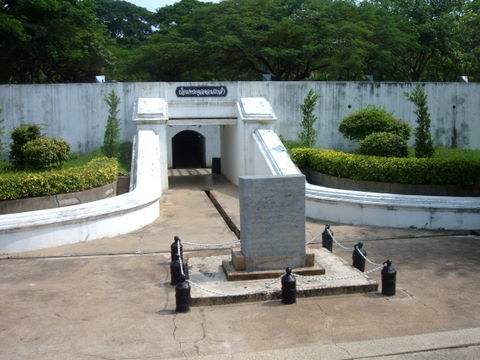 Main entrance to the fort
Main entrance to the fort
There are two layers of walls, the outer wall on the right and the inner wall on the left behind which tunnels and gun pits are dug in. 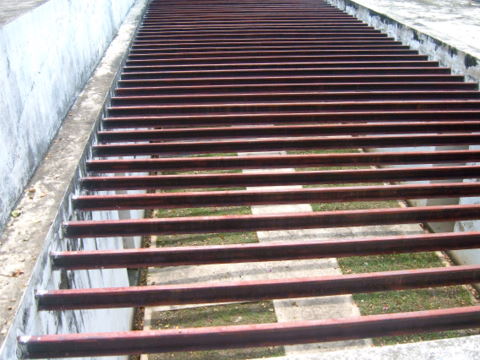 Double walls of the fort
Double walls of the fort
There are several entrances in the inner wall with entry tunnels leading into the fort which is entrenched into a hillock. 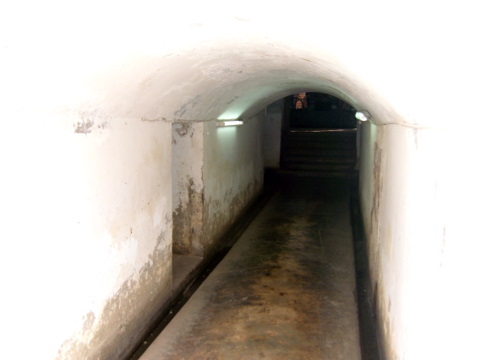 Entry tunnel
Entry tunnel
These entry tunnels will lead to connecting tunnels which in turn lead to the entrances of the various gun emplacements 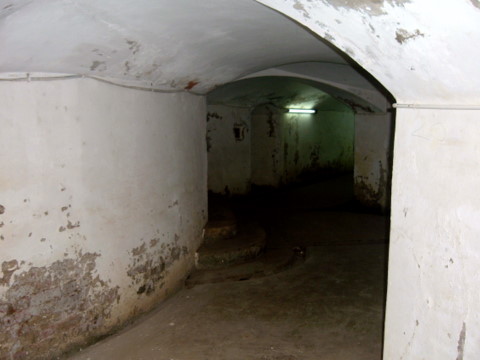 Connecting tunnel
Connecting tunnel
There are chambers on either side of each gun emplacement for storing ammunition. 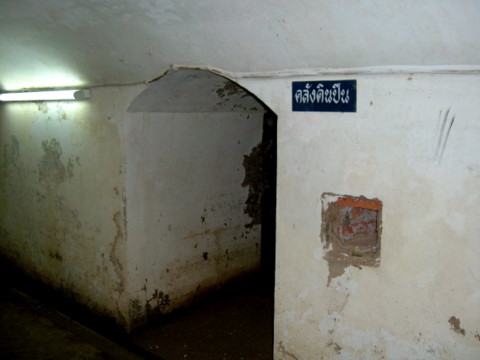 Storage for gunpowder used as propellant charges
Storage for gunpowder used as propellant charges
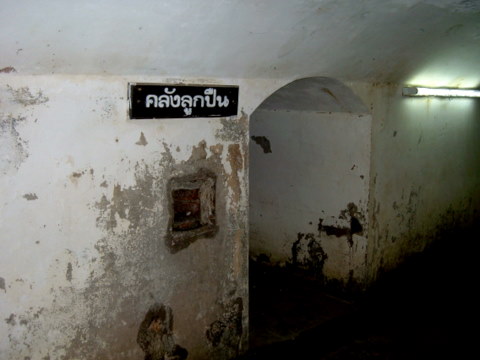 Storage for the main rounds of the guns
Storage for the main rounds of the guns
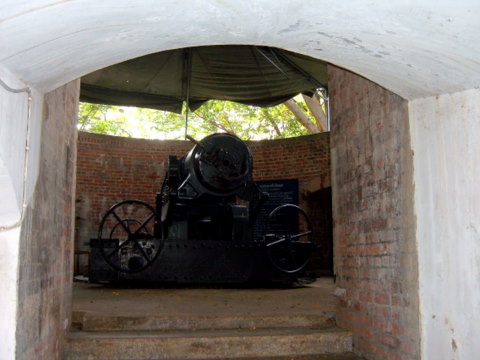 Entrance to the gun pit
Entrance to the gun pit
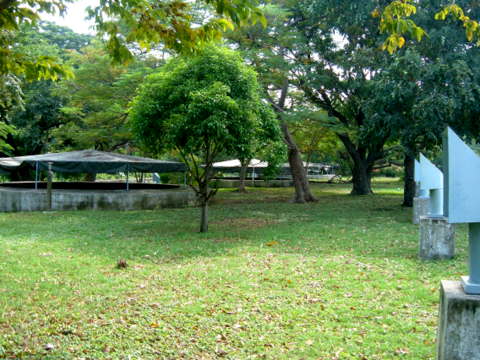 View of the fort at ground level, air vents to the right and gun
View of the fort at ground level, air vents to the right and gunemplacements on the left Fort Plaeng Faifah This fort is among the older forts and armed with older cannon. It’s the only remaining fort in Phra Pradaeng and is located next to the Pom Plaeng Faifah School, which is named after the fort. 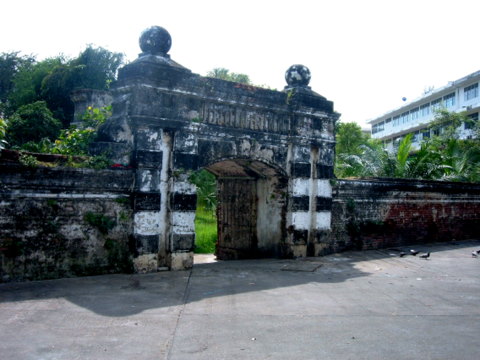 Entrance to the fort, the school is to the right
Entrance to the fort, the school is to the right
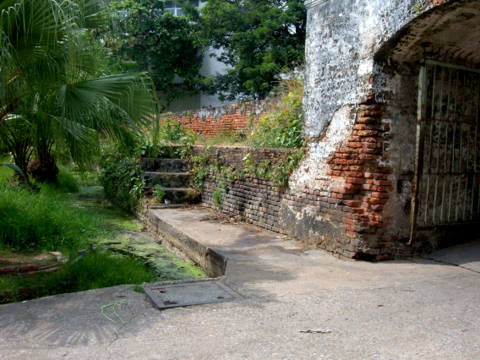 Past the main gate inside the fort
Past the main gate inside the fort
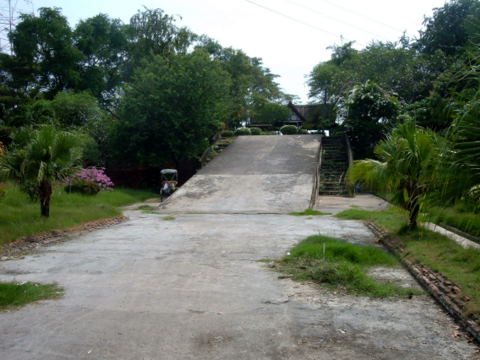 Ramp leading up to the ramparts facing the river, for hauling up the cannon and ammunition
Ramp leading up to the ramparts facing the river, for hauling up the cannon and ammunition
The front of the fort which is facing the river has double walls with shelters and storage areas built in the space between these walls. 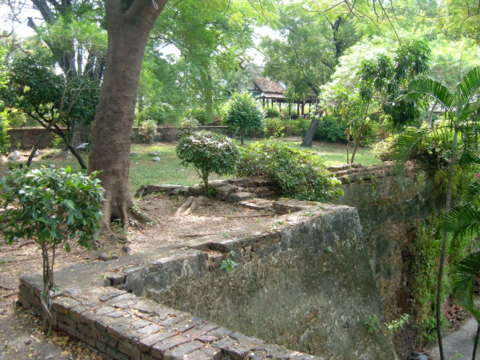 The double walls of the fort, the river is at the top of the photo
The double walls of the fort, the river is at the top of the photo
The guns in this fort are the older version deployed on the ramparts of the fort. They are not concealed in dug-in gun pits. 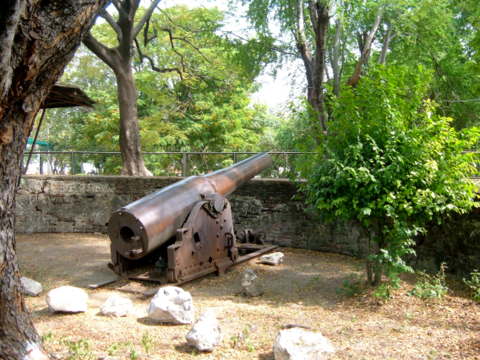 This gun doesn’t look complete, probably salvaged from somewhere else
This gun doesn’t look complete, probably salvaged from somewhere else
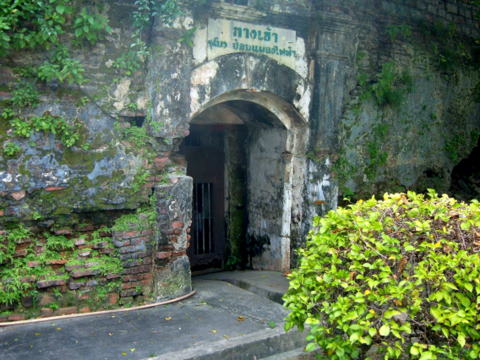 A locked gate probably leading to the living or storage areas within the double walls
A locked gate probably leading to the living or storage areas within the double walls
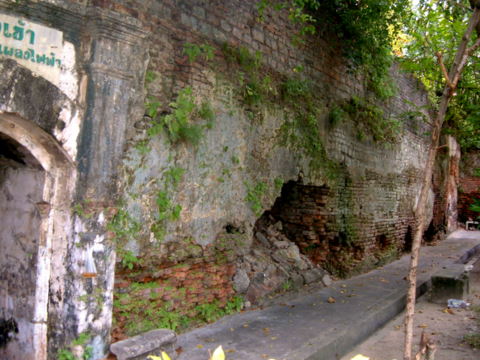 Deteriorated state of the inner wall
Deteriorated state of the inner wall
Fort Phi Suea Samut Fort Phi Suea Samut is on an island that’s a naval installation. These photos were taken from the ferry passing between Phra Samut Chedi and Paknam Market. 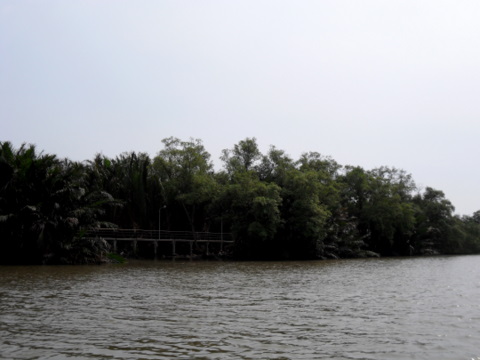 Island where the fort is located
Island where the fort is located
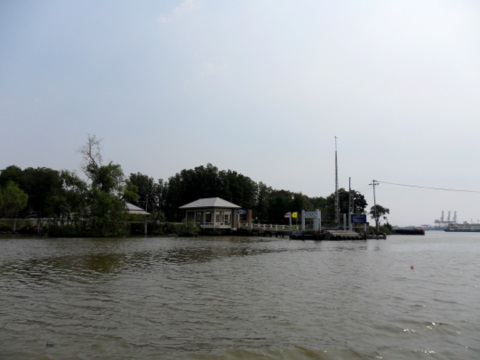 Navy pier
Navy pier
The fort is at the southern tip of the island. 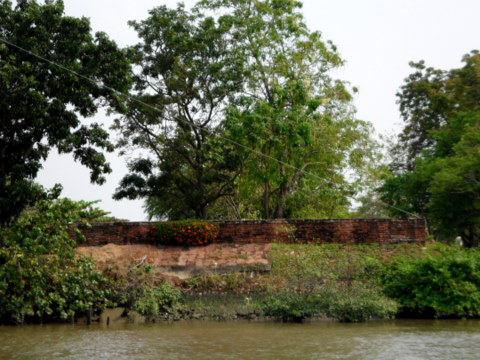 Walls of the old fort
Walls of the old fort
Like Fort Phra Chulachomklao, Fort Phi Suea Samut has underground gun pits linked by a network of tunnels. 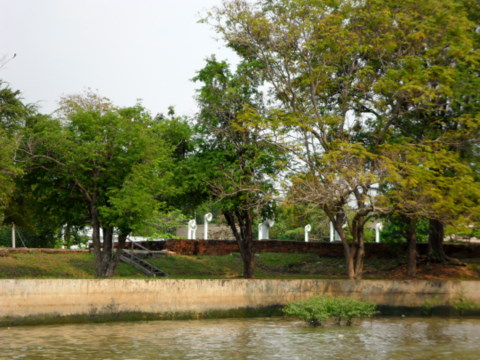 Air vents for the tunnels
Air vents for the tunnels
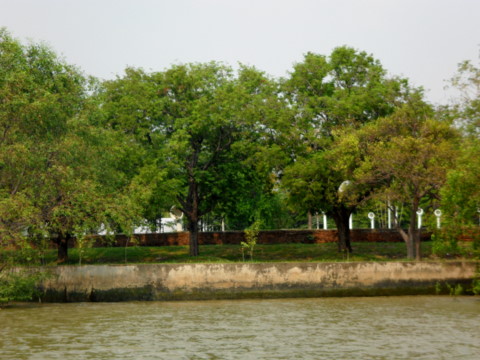 Only the low walls and air vents are visible from the sea
Only the low walls and air vents are visible from the sea
Table of contents The Armstrong guns The two newest forts Forts Phra Chulachomklao and Phi Suea Samut were armed with the latest coastal guns designed by Sir William George Armstrong of England. In the 1850s Armstrong started with field artillery for the army, then in 1860 naval guns for warships used by the major navies of the world. In 1905, ships in the Imperial Japanese Navy which defeated the Russian Baltic Fleet in the Battle of Tsushima were equipped with Armstrong naval guns. Armstrong guns also saw service in the American Civil War. Another variant of these guns was for coastal artillery. This particular model installed in the two Paknam forts has a rifled barrel and is rear breech loaded. The 152 mm calibre gun has a range of 8,046 m and a crew of 10 men. 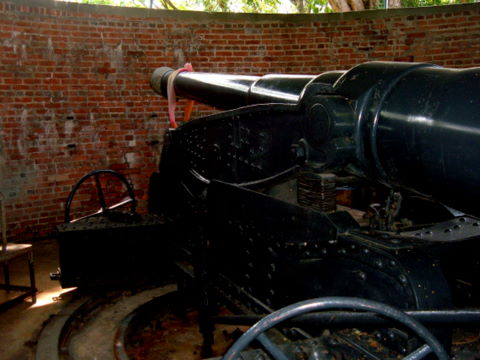 The Armstrong 152mm gun
The Armstrong 152mm gun
The special feature of these Armstrong guns was that they can be hydraulically raised on a platform for firing and lowered into guns pits for reloading or when not firing. As a result of this feature, the guns were called “disappearing guns” in English. 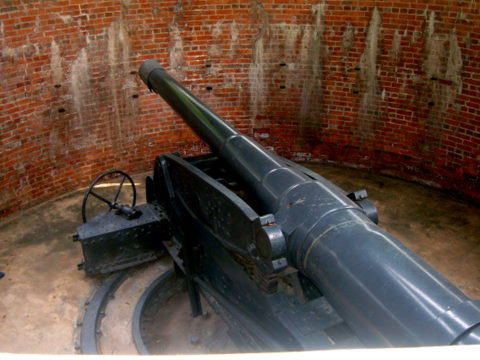 Gun in the lowered position
Gun in the lowered position
The name is far more dramatic in Thai, “crouching tiger gun”, like a hidden tiger crouching, waiting to pounce on its prey. 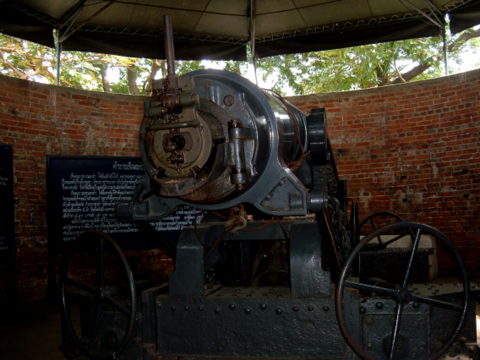 "Crouching tiger"
"Crouching tiger"
The obvious advantage of these guns was that they were concealed when not firing or reloading. The crew and gun were protected by a gun emplacement which didn’t need to be as heavily reinforced as a gun deployed at ground level. 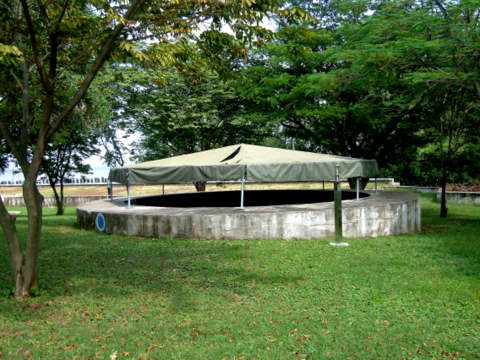 View of the gun emplacements at ground level
View of the gun emplacements at ground level
The disadvantages, however, were not so well publicised. The guns had a maximum elevation of 20 degrees which had a drastic limit on its range. Lowering of the gun for reloading also slowed down the rate of fire, crucial at a time when fighting ships were increasing in speed. This limitation could have had a telling effect in the impending encounter. Three months after these new guns were installed; they would fire their first shots in battle. Table of contents The Paknam Incident The French continued to pursue their dream of a greater empire stretching to the upper reaches of the Mekong. Expeditions were sent upriver to explore the area. At the same time, they resorted to historical claims to sovereignty over Laos. These claims were based on the dubious grounds that as Vietnam historically had suzerainty over Laos, France being the colonial government had succession to this right. In April 1893 the situation erupted. France occupied the east bank of the Mekong from the Chinese border to Cambodia. Siam mobilised her troops and clashed with the French. This gave the French ample excuse to escalate the conflict. On 13 July 1893, two gunboats, Comete and Inconstante, were sent to the Chao Phraya estuary together with a merchant ship acting as pilot ship, Jean Baptiste Say. Siam threatened to sink the gunboats if they attempted to enter the river mouth. The French ignored the warning. Fort Phra Chulachomklao fired warning shots and an exchange of fire ensued. The two French gunboats broke right through the defences and sailed to Bangkok to be joined by another gunboat Lutin, which was anchored there earlier. The Jean Baptiste Say was hit several times and floundered in the shallows. ((The New York Times 13 July 1893) At this time there were at least 25 Danish naval officers serving in the Siamese Navy, most of whom were captains of ships. The commander of Fort Phra Chulachomklao was a Danish captain. The commander of the Siamese Navy during this conflict was Admiral Andreas du Plessis de Richelieu. When the French broke through the Paknam forts, overwhelming the older and outgunned Siamese ships, Admiral de Richlieu asked permission to use the royal ship Maha Chakri specially manned by foreign officers to engage the French. But King Chulalongkorn forbade him from doing so for fear of aggravating the French further. Earlier the French government demanded that Siam dismiss the Danish officers, a demand which was disregarded. (The New York Times 25 August 1893) The Danish government also forbade their officers from participating in these hostilities, an order the Danish officers chose to ignore. (Scandasia Denmark) With Bangkok under the cannon of three gunboats and Paknam blockaded by more French ships which came later, the French pressed their demands. Table of contents Aftermath The blockade lasted 10 days. Siam paid a heavy price for this encounter. The concessions conceded by Siam to France gave an indication of the relative strength and weakness of the two sides. This humiliating defeat was a cause for much bitterness for the Siamese for years to come, giving rise to another war with France in 1940 over the disputed territories in Laos and Cambodia. Table of contents How to visit the Paknam forts How to get to Fort Phra Chulachomklao Go to Wong Wian Yai and take the air-conditioned bus service 20 from the bus stop in Lat Ya Road. Take the bus all the way to the terminal station at Phra Samut Chedi. Fare is 22 baht. From there, you’ll need to take a taxi or motor-cycle taxi to get to the fort which is about 6 km away. The fort is within a naval installation but is open to the public every day from 0800 – 1800 hours. Admission is free. Going back is a little tricky. You’ll need to wait for an incoming taxi with visitors. So if you’re not driving, go during the weekends when there are more visitors to the fort. How to get to Fort Phi Suea Samut This fort is on an island just off Phra Samut Chedi where bus service 20 terminates. It’s a restricted naval area and not opened to the public. There’s a ferry from Phra Samut Chedi pier crossing over to the Paknam market in Samut Prakarn city. From this ferry ride you’ll get a view of the fort. Ferry fare is 3.5 baht each way. How to get to Fort Plaeng Faifah Start from Wong Wian Yai again. This time go to the bus stop in Somdet Phrachao Taksin Road. Take the non-air-conditioned bus service 20 or 82. These are bright orange buses that are smaller than the usual buses but bigger than the mini-vans. This service will take you all the way to Phra Pradaeng. The fare is 6.5 baht. This service is very frequent, almost one every 10 minutes. The destination signs on the buses are all in Thai. If you’re not sure ask the conductor first. Please see the map of Wong Wian Yai for the location of the various bus stops for the different bus services. View Wong Wian Yai bus stops in a larger map Table of contents Next month The Jim Thompson Farm at Pak Thong Chai Free EBook – right-click on image or link below to download 
Click here to read the Netwriting Masters Course (Right-click to download) If you enjoyed reading this e-zine, please forward it to a friend. If you received this from a friend and found it interesting, please subscribe at Bangkok Travelbug.
|
| Back to Back Issues Page |